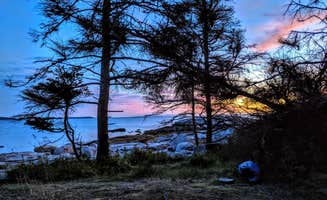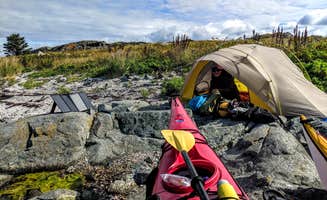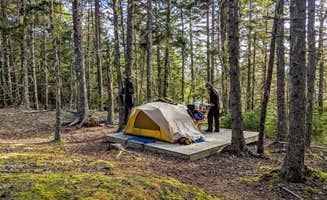Dispersed camping near Monhegan, Maine primarily involves island-based sites that require boat transportation and specialized preparation. Most primitive camping options are found within the archipelagos surrounding the mainland, with water depths averaging 60-180 feet between islands and tidal fluctuations of 8-12 feet daily. These remote sites experience typical coastal Maine weather patterns with average summer temperatures between 65-75°F and frequent morning fog that burns off by midday.
What to do
Explore island trails: Buckle Island offers accessible wooded trails that connect camping areas to shore points. "This is a perfect island for those new to sea kayak camping as the sandy shore, which is exposed for a good portion of the day, is easy to land on and a short walk to a trail into the woods," notes camper Shari G.
Wildlife observation: The Gulf of Maine waters host diverse marine species including harbor seals, porpoises, and numerous seabirds. Marshall Island provides excellent wildlife viewing opportunities from its protected coves. One visitor reports, "Despite the fact that the other islands had pesky mosquitoes, this site had none."
Beach combing: Coastal areas around these islands contain extensive shell deposits and interesting geological formations. "Gorgeous shell covered beach and a beautiful view of Isle au Haut, just next door," mentions a camper about the shorelines at the smaller islands.
What campers like
Night sky visibility: Wheat Island provides exceptional celestial viewing opportunities away from light pollution. According to reviews, the southwest side has a "gorgeous view of the sun setting and full moon rising" making it popular among stargazers.
Strategic island hopping: The cluster arrangement allows for multi-day paddling trips between camping locations. "Perfect island for exploring the close-by Isle au Haut, a remote section of Acadia National Park," notes one camper about using these islands as bases for extended exploration.
Beach fires: Select islands permit shoreline fires in designated areas, adding to the rustic camping experience near Monhegan. One camper mentions that Sand Cove is "a truly gorgeous wooded area with a tent platform and a picnic table at each site."
What you should know
Landing conditions: Accessing Doliver Island requires careful tide timing. "This can be a tricky island to land on at high tide, so plan accordingly," warns a recent visitor. Most landing areas feature rocky or shell-covered shores rather than sandy beaches.
Supply requirements: All islands require self-sufficiency for the entire stay duration. No potable water sources exist on any of the islands, and campers must pack out all waste. Bring wag bags for human waste management as there are no toilet facilities.
Membership considerations: While sites remain free, access requires Maine Island Trail Association (MITA) membership. The annual fee provides detailed access information and supports conservation efforts for these primitive sites.
Tips for camping with families
Site selection: Choose larger islands for family camping needs. The southwest side of Wheat Island offers more space than other locations, described as "perfect for larger groups" in camper reviews.
Conservation opportunities: Marshall Island offers educational opportunities through beach cleanup activities. "If you do a beach clean-up during your stay and send in a picture, you will receive a Maine Coast Heritage Trust hat," notes one visitor, making conservation a rewarding family activity.
Weather preparation: Summer coastal weather remains variable with frequent temperature changes. Morning fog commonly occurs but typically clears by midday. Bring layers even during summer months.
Tips from RVers
Alternative accommodations: Traditional RV camping near Monhegan is non-existent due to island geography. RV travelers must park vehicles on the mainland and arrange boat transportation to island sites.
Storage options: No secure storage exists for RVs while owners camp on islands. Consider commercial campgrounds in mainland communities like Rockland or Boothbay Harbor as base camps while doing day trips to islands.
Equipment transfer: Lightweight, collapsible camping equipment proves most practical for boat transfer to primitive islands. Standard RV camping supplies typically exceed practical carrying capacity for small watercraft.





